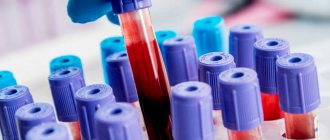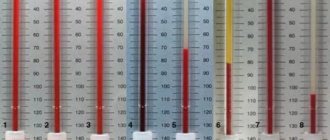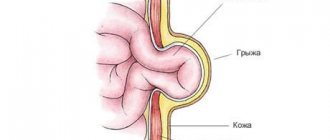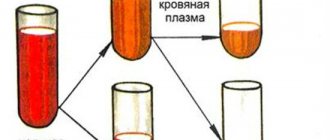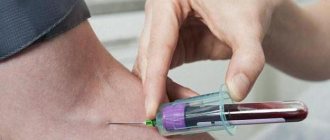general characteristics
Serum IgM makes up 5-10% of the total amount of immunoglobulins and is synthesized by mature B lymphocytes. IgM is the evolutionarily most ancient class of antibodies, primarily providing the primary immune response. Half-life 4-5 days. Activate complement via the classical pathway. They are the most large-molecular in structure. They do not pass through the placenta, so the detection of Ig M antibodies in a newborn confirms that the child himself is infected. IgM antibodies bind most effectively to complement, cause agglutination of bacteria, neutralize viruses, and play an important role in activating phagocytosis and eliminating pathogens from the bloodstream. The class of IgM immunoglobulins also includes isohemagglutinins, rheumatoid factor (in the early stages of the disease), and cold agglutinins. Some IgM is produced locally and is classified as secretory. Determining the content of serum immunoglobulin M has clinical and diagnostic significance for: recurrent, chronic or severe infections, rheumatoid arthritis and autoimmune diseases, tumor diseases, chronic hepatitis, liver cirrhosis, for monitoring the treatment of Waldenström's macroglobulinemia.
Indications for research
Frequent indications for immunoglobulin analysis are recurrent and chronic infectious diseases. The study is prescribed for patients with bacterial damage to the respiratory tract - sinusitis, pneumonia, tonsillitis. Also, suspicion of reduced activity of humoral immunity arises with prolonged and frequently recurring otitis, with meningitis, with symptoms of gastrointestinal infections. Immunoglobulin M is used to detect intrauterine infections. In addition, a blood test for immunoglobulins is performed for tumor diseases of the lymphoid system - myeloma, leukemia, lymphoma, reticulosarcoma, as well as for autoimmune diseases and liver pathologies.
The advantage of the analysis is its high information content - the results reflect several parts of the humoral immune response at once: the body’s ability to quickly recognize a foreign agent, the formation of antigenic “memory”, and the activity of protecting the mucous membranes. Sometimes some decrease in indicators is transient and reversible. To differentiate such a deviation from a truly existing violation of the body's anti-infective defense, this study is prescribed together with a test for CEC and phenotyping of lymphocytes.
Preparation for analysis and collection of material
Immunoglobulins are determined in venous blood; sampling is recommended to be done in the morning, before meals. If the procedure is scheduled for another time, then at least 4 hours should pass after eating. The day before the test, you need to avoid alcohol, cancel sports training and other types of intense exercise. 3 hours before donating blood, you must refrain from smoking; the last 30 minutes should be spent in a calm environment. Some medications change the level of immunoglobulins in the blood, so you should tell your doctor about all medications you use. Blood is taken from the cubital vein, stored and transported in tubes with an anticoagulant.
The level of immunoglobulins is examined in the blood serum. Before the analysis procedure, the tubes are placed in a centrifuge, and then clotting factors are removed from the separated plasma. A common research method is immunoturbidimetry. Its essence lies in the fact that antigens are introduced into the serum, which form complexes with immunoglobulins. The density of the test sample increases, which is measured using a photometer; based on the obtained indicators, the level of immunoglobulins is calculated.
Interpretation:
- Hyper-IgM syndrome, IgM-type multiple myeloma, asymptomatic monoclonal IgM gammopathy, Waldenström's macroglobulinemia, viral hepatitis, infectious mononucleosis, acute and chronic purulent infections, intrauterine infections in newborns (umbilical cord blood), bacterial and parasitic infections (early signs), enteropathy , hepatitis, biliary cirrhosis, rheumatoid arthritis.
- It can be observed both in combination with a decrease in other classes of immunoglobulins and indicators of the immune system (Bruton's disease, common variable immunodeficiency, combined immunodeficiencies), and an isolated defect (selective deficiency of immunoglobulin M is determined at a level below 0.2 g / l), lymphoma, monoclonal (non-IgM) gammopathy.
Sample result (PDF)
Normal values
Immunoglobulins G penetrate through the placenta to the fetus, so their level in newborns is high, and during the first year it decreases, as maternal immunoglobulins are replaced with their own. The normal limits depend on the age and gender of the patient.
- in the first month of life – 3.97-17.65 g/l for boys, 3.91-17.37 g/l for girls
- from 1 month to one year – 2.05-9.48 g/l for boys, 2.03-9.34 g/l for girls
- from one year to 2 years – 4.75-12.10 g/l for boys, 4.83-12.26 g/l for girls
- from 2 to 80 years – 5.40-18.22 g/l for boys and men, 5.52-16.31 g/l for girls and women
Immunoglobulins A are unable to cross the placental barrier; in newborns, their concentration in the blood is very low. Self-synthesis of antibodies is fully established by the age of 5 years. The normal values for immunoglobulin A are:
- in the first 3 months of life – 0.01-0.34 g/l
- from 3 months to a year – 0.08-0.91 g/l
- from one year to 12 years – 0.21-2.91 g/l for boys, 0.21-2.82 g/l for girls
- from 12 to 60 years – 0.63-4.84 g/l for boys and men, 0.65-4.21 g/l for girls and women
- after 60 years – 1.01-6.45 g/l for men, 0.69-5.17 g/l for women
Immunoglobulins M have a large molecular weight and do not cross the placenta during pregnancy. In children, the concentration of antibodies increases gradually, reaching adult values by the age of 7-12 years:
- in the first 3 months of life – 0.06-0.21 hl
- from 3 months to one year – 0.17-1.43 g/l for boys, 0.17-1.50 g/l for girls
- from one year to 12 years – 0.41-1.83 g/l for boys, 0.47-2.40 g/l for girls
- after 12 years – 0.22-2.40 g/l for boys and men, 0.33-2.93 g/l for girls and women
A physiological decrease in the level of immunoglobulins can be detected during pregnancy, an increase - during intense physical activity or the experience of strong emotions.
Level up
Immunoglobulins are markers of an infectious process in the body; the most common reason for an increase in their level in the blood is respiratory and gastrointestinal infections. An increase in the concentration of IgG and IgA antibodies is characteristic of chronic processes; the number of IgM antibodies increases in both acute and chronic forms of diseases. Other reasons for increased levels of immunoglobulins include autoimmune pathologies, liver damage, as well as multiple myeloma and other monoclonal gammopathies.
Level reduction
The most common reason for a decrease in immunoglobulin levels is acquired deficiency. The concentration of antibodies decreases when their production is disrupted - with neoplasms of the lymphatic system, lymphoproliferative diseases. In addition, the level of immunoglobulins decreases with their increased breakdown and rapid elimination of protein - during irradiation, the use of drugs (for example, cytostatics), enteropathies, nephropathies and burns. Less commonly, the cause of a decrease in immunoglobulin levels is congenital deficiency. It develops with congenital agammaglobulinemia, ataxia-telangiectasia (IgA), Wiskott-Aldrich syndrome (IgG) and selective IgM deficiency.
full list of articles
Antibody structure
Content:
- General characteristics of immunoglobulins
- Antibody structure
- Types of immunoglobulins
- Characteristics of different classes of immunoglobulins
- The role of immunoglobulins in the body
- Antibodies and immunological memory
- How to determine the amount of antibodies
- Immunoglobulins and vaccination
- Antibodies in medicine
Immunoglobulins are symmetrical Y-shaped molecules consisting of two long heavy ones (H) and two short light ones (L). chains that are connected to each other either by disulfide (SS) or hydrogen bonds. Each immunoglobulin molecule contains at least two identical H chains. The heavy chains of immunoglobulins of different classes consist of four or five domains and are designated by the letters of the Greek alphabet according to the Latin abbreviation of the class. The belonging of an antibody to a specific class and subclass is called an isotype, which is designated by the type of heavy chain. Light chains are built from two domains. They necessarily contain two types of domains - variable (V - variable) and constant (C-copstapt). Immunoglobulins produced by different clones of plasma cells have variable domains of different amino acid sequences. The constant domains are similar or very similar for each immunoglobulin isotype. Variable domains are N-terminal. As part of the light chain, the N-terminal domain is variable (VL), and the C-terminal domain is constant (CL). Heavy chains have one variable (N-terminal) domain (Vn) and several constant domains. The light and heavy chains of immunoglobulins are glycosylated.
In other words, each antibody approaches the antigen like a key and lock, and when combined, they form immune complexes. But antibodies are also capable of exhibiting the flexibility of foreign agents, making it easy to adapt to various antigens. However, this ability of immunoglobulins sometimes provokes cross-allergic reactions in a person - when the immune system of a person with allergies cannot distinguish between allergens. For example, a person with a pollen allergy due to an immunoglobulin “error” may also react to raw fruits and vegetables.
Function of immunoglobulin IgG
Immunoglobulins G deactivate viral and bacterial toxins and trigger complement-fixing reactions and phagocytosis. Due to their small molecular weight, they quickly and easily enter the extracellular space, where they perform a protective function. Immunoglobulins G are able to penetrate the placental barrier and enter the blood of the fetus from the mother's blood.
Antibodies are part of the humoral immune response; they act very specifically, since they are always directed against a specific antigen. Their purpose is to participate in immune reactions. Immunoglobulins form immune complexes with antigen molecules, activate the complement system and cause inflammatory reactions. This aims to neutralize the irritant and safely remove it from the body.
Each class of antibodies has different structural properties, so they perform specialized functions. In particular, immunoglobulin G is capable of:
- neutralize microorganisms;
- prevent relapses of diseases, for example, mumps, chickenpox, measles, rubella;
- protect the fetus.
What can affect immunoglobulin G?
It is important to know that during intense muscle loads, as well as psychological stress, the level of immunoglobulin G can physiologically increase. In addition, immunization in the last 6 months or taking medications may increase the level.
Agents that increase the concentration of immunoglobulin G:
- valproic acid;
- carbamazepine;
- phenytoin;
- chlorpromazine;
- penicillamine;
- dextran;
- oral contraceptives;
- methylprednisolone;
- gold preparations;
- estrogens.
The level of immunoglobulin G can be reduced by:
- burns received;
- radiation exposure;
- taking cytostatics and immunosuppressants;
- intestinal pathologies that are accompanied by protein loss, for example, ulcerative colitis, Crohn's disease;
- renal failure, nephrotic syndrome.
General information
Immunoglobulin M is produced only in the initial stage of the disease - at this moment the concentration of IgM in the blood serum rapidly increases. After 5 days (the half-life of M antibodies), class G immunoglobulins are synthesized. This is a kind of “heavy artillery” of the body, designed to finally eliminate the pathological focus.
However, IgM is an indispensable participant in the process of protecting the body in case of acute infection. They are the ones that are released into the bloodstream faster than all other antibodies and reach pathogenic cells, thereby providing humoral (primary) immunity.
Functions of immunoglobulin M
- Bonding and sedimentation of pathogenic microorganisms;
- Activation of the process of phagocytosis (absorption/eating of foreign agents by immune cells).
